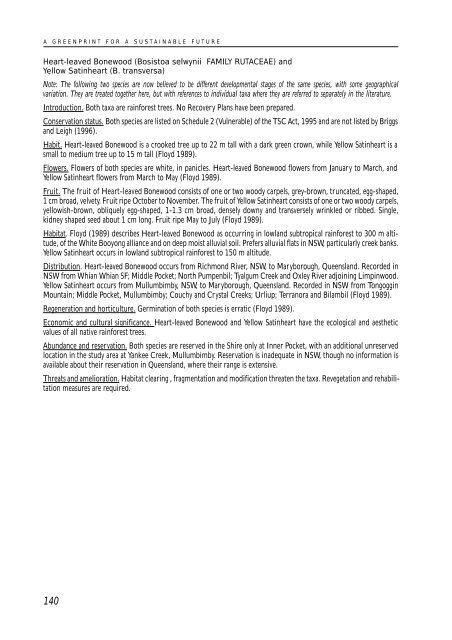Byron Flora and Fauna Study 1999 - Byron Shire Council
Byron Flora and Fauna Study 1999 - Byron Shire Council
Byron Flora and Fauna Study 1999 - Byron Shire Council
You also want an ePaper? Increase the reach of your titles
YUMPU automatically turns print PDFs into web optimized ePapers that Google loves.
A GREENPRINT FOR A SUSTAINABLE FUTURE<br />
Heart-leaved Bonewood (Bosistoa selwynii FAMILY RUTACEAE) <strong>and</strong><br />
Yellow Satinheart (B. transversa)<br />
Note: The following two species are now believed to be different developmental stages of the same species, with some geographical<br />
variation. They are treated together here, but with references to individual taxa where they are referred to separately in the literature.<br />
Introduction. Both taxa are rainforest trees. No Recovery Plans have been prepared.<br />
Conservation status. Both species are listed on Schedule 2 (Vulnerable) of the TSC Act, 1995 <strong>and</strong> are not listed by Briggs<br />
<strong>and</strong> Leigh (1996).<br />
Habit. Heart-leaved Bonewood is a crooked tree up to 22 m tall with a dark green crown, while Yellow Satinheart is a<br />
small to medium tree up to 15 m tall (Floyd 1989).<br />
Flowers. Flowers of both species are white, in panicles. Heart-leaved Bonewood flowers from January to March, <strong>and</strong><br />
Yellow Satinheart flowers from March to May (Floyd 1989).<br />
Fruit. The fruit of Heart-leaved Bonewood consists of one or two woody carpels, grey-brown, truncated, egg-shaped,<br />
1 cm broad, velvety. Fruit ripe October to November. The fruit of Yellow Satinheart consists of one or two woody carpels,<br />
yellowish-brown, obliquely egg-shaped, 1-1.3 cm broad, densely downy <strong>and</strong> transversely wrinkled or ribbed. Single,<br />
kidney shaped seed about 1 cm long. Fruit ripe May to July (Floyd 1989).<br />
Habitat. Floyd (1989) describes Heart-leaved Bonewood as occurring in lowl<strong>and</strong> subtropical rainforest to 300 m altitude,<br />
of the White Booyong alliance <strong>and</strong> on deep moist alluvial soil. Prefers alluvial flats in NSW, particularly creek banks.<br />
Yellow Satinheart occurs in lowl<strong>and</strong> subtropical rainforest to 150 m altitude.<br />
Distribution. Heart-leaved Bonewood occurs from Richmond River, NSW, to Maryborough, Queensl<strong>and</strong>. Recorded in<br />
NSW from Whian Whian SF; Middle Pocket; North Pumpenbil; Tyalgum Creek <strong>and</strong> Oxley River adjoining Limpinwood.<br />
Yellow Satinheart occurs from Mullumbimby, NSW, to Maryborough, Queensl<strong>and</strong>. Recorded in NSW from Tongoggin<br />
Mountain; Middle Pocket, Mullumbimby; Couchy <strong>and</strong> Crystal Creeks; Urliup; Terranora <strong>and</strong> Bilambil (Floyd 1989).<br />
Regeneration <strong>and</strong> horticulture. Germination of both species is erratic (Floyd 1989).<br />
Economic <strong>and</strong> cultural significance. Heart-leaved Bonewood <strong>and</strong> Yellow Satinheart have the ecological <strong>and</strong> aesthetic<br />
values of all native rainforest trees.<br />
Abundance <strong>and</strong> reservation. Both species are reserved in the <strong>Shire</strong> only at Inner Pocket, with an additional unreserved<br />
location in the study area at Yankee Creek, Mullumbimby. Reservation is inadequate in NSW, though no information is<br />
available about their reservation in Queensl<strong>and</strong>, where their range is extensive.<br />
Threats <strong>and</strong> amelioration. Habitat clearing , fragmentation <strong>and</strong> modification threaten the taxa. Revegetation <strong>and</strong> rehabilitation<br />
measures are required.<br />
140

















